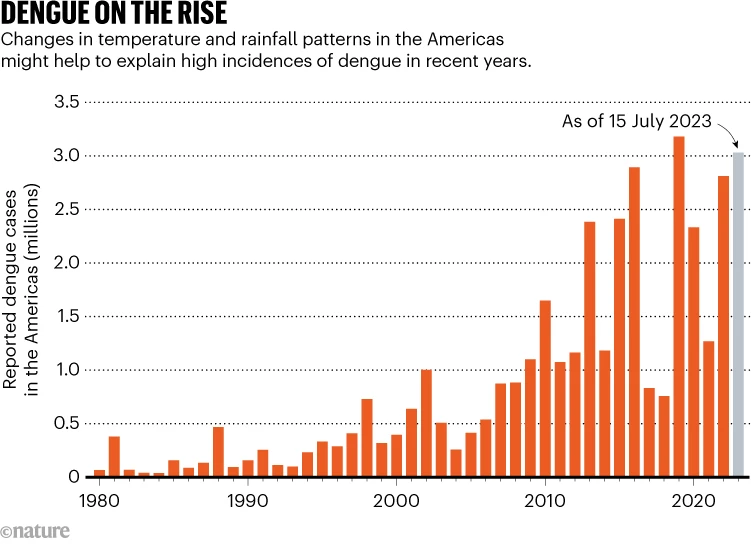Increasing temperatures contribute to longer dengue seasons, and could drive the geographical expansion of the disease.
More than three million cases of dengue have been reported in the Americas so far this year. That means 2023 already has the second-highest annual incidence of the disease since 1980, when the Pan American Health Organization began collecting data on the number of cases (see ‘Dengue on the rise’).
“We do observe an increase in cases beyond what was expected for this period,” says Cláudia Codeço, an epidemiologist at the Oswaldo Cruz Foundation, a biosciences and public-health institution in Rio de Janeiro, Brazil. Whether the record of 3.2 million cases reported in 2019 will be broken in 2023 depends on how the disease spreads in Central and North America, because most researchers think the peak of dengue season in South America has passed

Source: Pan American Health Organization.
Dengue is caused by four closely related viruses, or serotypes, which makes identifying the exact cause of the surge challenging. “There is an interaction between these serotypes, with the immunity against one interfering with the others. When we put this together, it can lead to unpredictable dynamics,” Codeço says.
But rising temperatures and changes in rainfall patterns might help to explain the trend, researchers say. Dengue’s main vector, the Aedes aegypti mosquito, thrives at temperatures around 30 °C and in humid conditions, which have become more frequent in the past few years as a result of record heat and extreme weather events.
There is no specific treatment for the disease, which can cause fever, headache and fatigue. Severe cases can be fatal: more than 1,300 people have died from dengue in the Americas so far this year.
Range expansion
Dengue is spreading to regions that were once off-limits to A. aegypti. In Brazil — which has reported nearly 2.4 million cases this year — the disease is expanding into southern states, which were previously too cold for the mosquito. Over the past 5 years, 481 Brazilian municipalities have registered sustained local transmission of dengue for the first time, according to an analysis by Codeço and her colleagues1. And Mexico City, at an altitude of 2,240 metres, recorded its first A. aegypti invasion in 2015. “If you read books about the biology of the Aedes aegypti, they say the mosquito doesn’t reproduce at altitudes above 1,200 metres,” says José Ramos-Castañeda, a virologist at the Mexican National Institute of Public Health in Cuernavaca. “In that aspect, global warming is affecting the distribution of the vector and therefore the possible distribution of cases.”
Researchers at the University of Michigan in Ann Arbor have investigated how rising temperatures in parts of Brazil might affect dengue’s epidemic potential — the chance of it spreading among people — in the late 2040s2. “What we found was that, regardless of the specific climate-change scenario, the epidemic potential was higher than today,” says computational epidemiologist Andrew Brouwer, one of the authors of the study. “In most locations, we’ve seen a 10–20% increase in the epidemic potential,” he says.
The phenomenon is not restricted to South America. “Both in the Southern and Northern Hemisphere, the regions where vector and pathogen can be sustained are going to be increasing,” says Brouwer. In the continental United States, local transmission of dengue has already been registered in Florida, Texas and Arizona.
Longer seasons
Dengue is typically seasonal — case numbers tend to go up in summer or the rainy season and down in winter or the dry season. But global temperature increases mean that dengue seasons might get longer. In Brouwer and his colleagues’ projection, “we found that the transmission seasons generally increased by about a month on either end”, Brouwer says.
In the short term, the ongoing El Niño weather event — which is expected to bring floods, droughts and record temperatures — could have consequences for dengue. In late June, the director-general of the World Health Organization, Tedros Adhanom Ghebreyesus, warned that the phenomenon “could increase transmission of dengue and other so-called arboviruses such as Zika and chikungunya”.
El Niño will probably have the greatest impact on dengue incidence in Central America and parts of North America, regions that are now going through the rainy season.
Several strategies have been used to control dengue transmission. They include the use of traps or insecticides to kill the mosquito host, and getting rid of open containers of stagnant water, where the insects can breed. There are also efforts to develop modified mosquitoes that cannot transmit the disease.
All these approaches can help, says Ramos-Castañeda, but “the thing that could really impact the transmission is immunity in the population”. Two dengue vaccines have been approved by authorities in some locations since 2015, but they haven’t been widely adopted, owing to issues with efficacy, safety concerns and high prices.
doi: https://doi.org/10.1038/d41586-023-02423-w



Recommended Comments
There are no comments to display.
Join the conversation
You can post now and register later. If you have an account, sign in now to post with your account.
Note: Your post will require moderator approval before it will be visible.